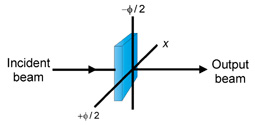Optipedia • SPIE Press books opened for your reference.
Wave Plates
Excerpt from Field Guide to Polarization
Wave plates have the property that along the x-axis (called the fast axis) the x component of the field experiences a phase shift of +φ/2 and, similarly,  along the y-axis (called the slow axis) the y component experiences a phase shift of
along the y-axis (called the slow axis) the y component experiences a phase shift of
-φ/2. The configuration for the wave plate is seen in the figure.
The Mueller matrix for a wave plate is then found to be

where φ is the total phase shift between the orthogonal components of the beam. Two forms of the Mueller matrices that are very important in polarization are the quarter-wave plate (QWP) (φ = π/2) and the half-wave plate (HWP) (φ = π):

The QWP has the interesting property that it transforms L+45P light to RCP light. This is shown in the following Stokes vector calculation:

Similarly, RCP light is transformed to L-45P light:

The HWP has the unique property in that it reverses the ellipticity and orientation angles of the polarization ellipse:

The orientation and ellipticity angles are expressed, respectively, for the output beam by

Comparing the elements of the Stokes vector shows that

E. Collett, Field Guide to Polarization, SPIE Press, Bellingham, WA (2005).
View SPIE terms of use.

